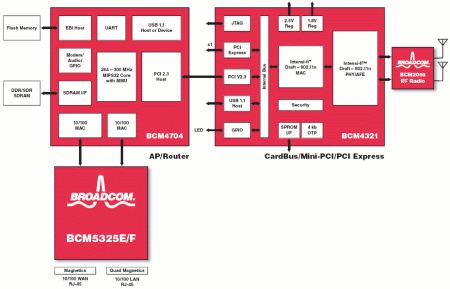First 802.11n draft-compliant reference designs run Linux
Apr 26, 2006 — by LinuxDevices Staff — from the LinuxDevices Archive — 15 views Broadcom is shipping the first wireless access point and add-in card reference designs compliant with the 802.11n draft specification, it claims. The Intensi-fi designs use Broadcom's Intensi-fi chipset, and include miniPCI, Cardbus, and PCI Express cards, as well as a MIPS-Linux based access point… design.
Broadcom is shipping the first wireless access point and add-in card reference designs compliant with the 802.11n draft specification, it claims. The Intensi-fi designs use Broadcom's Intensi-fi chipset, and include miniPCI, Cardbus, and PCI Express cards, as well as a MIPS-Linux based access point… design.
(Click for larger view of Intensi-fy WAP reference board)
Broadcom says its Intensi-fi chipset will enable next-generation Wi-Fi devices to support voice, video, and data applications, while maintaining compatibility with existing 802.11a/b/g products. It hopes the chipset will extend beyond traditional PCs, to consumer electronics, handhelds, printers, digital cameras, digital video recorders, cable set-top boxes, game consoles, and audio equipment.
Broadcom describes the chips comprising its Intensi-fi chipset as follows:
- BCM4321 — the world's first draft-802.11n media access controller (MAC) and baseband processor, providing data rates of over 300 Mbps and interfacing to PCI, Cardbus, and PCI-Express hosts.
- BCM2055 — Broadcom's fifth-generation 802.11 radio, which integrates multiple 2.4 and 5 GHz radios to support simultaneous spatial streams for draft 802.11n products with 2×2, 3×3, or 4×4 antenna configurations; the BCM2055 is the best-performing 802.11 radio, featuring smaller die size, lower power consumption, and lower phase noise and error vector magnitude (EVM) than competing products, Broadcom claims
Add-in cards based on the Intensi-fi chipset include miniPCI, Cardbus, and PCI Express designs. The designs are based on low-cost PCB (printed circuit board) technology and single-sided assembly, according to the company. Drivers are available for Windows XP and Windows 2000.

MiniPCI, PCI Express, and Cardbus designs
Additionally, an Intensi-fi access point design is available, powered by a choice of MIPS-based SoCs (system-on-chip processors). The BCM4704 boasts a proven design previously used in 24-port Gigabit Ethernet switches and wireless access point designs, while the BCM4705 is described as a “sixth-generation wireless network processor” supporting simultaneous operation of 2.4 and 5 GHz radios. The BCM4705 also integrates an integrated Gigabit Ethernet MAC “to enable greater than 100 Mbps throughput between draft 802.11n and Ethernet networks,” according to Broadcom.

Broadcom Intensi-fi access point reference design architecture diagram
(Click to enlarge)
The Intensi-fi access point reference design supports Linux and VxWorks operating systems, according to then company.
Earlier this week, LinkSys shipped a Linux-based WRT300N access point, claiming it to be the first commercially available product based on the 802.11n draft specification. LinkSys does not comment on the chips it builds into its product, it says; however, the WRT300N does appear to be based on the Intensi-fi chips, as readers willing to download and review its 178MB GPL source code may verify. The LinkSys router appears to use a lot of open source software, including mipsel linux 3.2.3, mipsel-uclibc 0.9.19, OpenSSL, and zebra.
The WRT300N was reviewed this week by eWEEK.
This article was originally published on LinuxDevices.com and has been donated to the open source community by QuinStreet Inc. Please visit LinuxToday.com for up-to-date news and articles about Linux and open source.